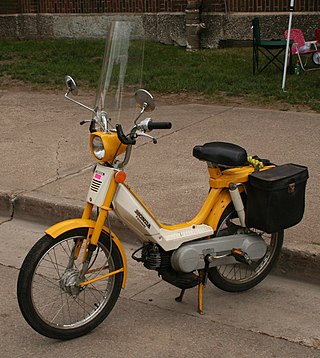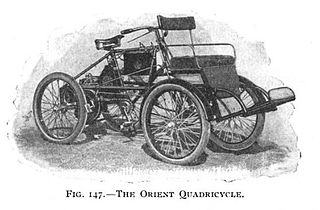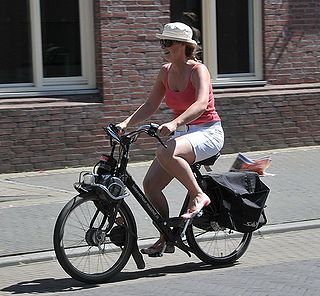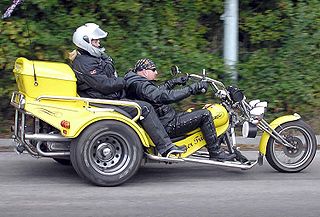Related Research Articles

A motorcycle is a two or three-wheeled motor vehicle steered by a handlebar from a saddle-style seat.

A moped is a type of small motorcycle, generally having a less stringent licensing requirement than full motorcycles or automobiles. Historically,the term exclusively meant a similar vehicle with both bicycle pedals and a motorcycle engine. Mopeds typically travel only a bit faster than bicycles on public roads.

Quadricycle refers to vehicles with four wheels.

A motorcycle engine is an engine that powers a motorcycle. Motorcycle engines are typically two-stroke or four-stroke internal combustion engines, but other engine types, such as Wankels and electric motors, have been used.

The six main types of motorcycles are generally recognized as standard, cruiser, touring, sports, off-road, and dual-purpose. Sport touring is sometimes recognized as a seventh category or integrated with the touring category.

A motorized bicycle is a bicycle with an attached motor or engine and transmission used either to power the vehicle unassisted, or to assist with pedalling. Since it sometimes retains both pedals and a discrete connected drive for rider-powered propulsion, the motorized bicycle is in technical terms a true bicycle, albeit a power-assisted one. Typically they are incapable of speeds above 52 km/h (32 mph).

Solex is a brand name owned by a subsidiary of Italian automotive parts manufacturer, Magneti Marelli. The original Solex company was French-owned and produced carburetors and gasoline powered bicycles.
The history of the motorcycle begins in the second half of the 19th century. Motorcycles are descended from the "safety bicycle," a bicycle with front and rear wheels of the same size and a pedal crank mechanism to drive the rear wheel. Despite some early landmarks in its development, the motorcycle lacks a rigid pedigree that can be traced back to a single idea or machine. Instead, the idea seems to have occurred to numerous engineers and inventors around Europe at around the same time.
Hero Motors is a former moped and scooter manufacturer based in Delhi, India. It is a part of multinational company Hero Motors Company, which also currently owns Hero Motocorp and Hero Cycles, among others. Hero Motors was started in the 1960s to manufacture 50 cc two-stroke mopeds but gradually diversified into making larger mopeds, mokicks and scooters in the 1980s and the 1990s. Noteworthy collaborators and technical partners were Puch of Austria and Malaguti of Italy manufacturing Puch Maxi Plus and Malaguti Centro respectively in India with updated engines.

A scooter is a motorcycle with an underbone or step-through frame, a seat, and a platform for the rider's feet, emphasizing comfort and fuel economy. Elements of scooter design were present in some of the earliest motorcycles, and motor scooters have been made since at least 1914.

The following outline is provided as an overview of motorcycles and motorcycling:

The Michaux-Perreaux steam velocipede was a steam powered velocipede made in France sometime from 1867 to 1871, when a small Louis-Guillaume Perreaux commercial steam engine was attached to a Pierre Michaux manufactured iron framed pedal bicycle. It is one of three motorcycles claimed to be the first motorcycle, along with the Roper steam velocipede of 1867 or 1868, and the internal combustion engine Daimler Reitwagen of 1885. Perreaux continued development of his steam cycle, and exhibited a tricycle version by 1884. The only Michaux-Perreaux steam velocipede made, on loan from the Musée de l'Île-de-France, Sceaux, was the first machine viewers saw upon entering the Solomon R. Guggenheim Museum rotunda in The Art of the Motorcycle exhibition in New York in 1998.

The Roper steam velocipede was a steam-powered velocipede built by inventor Sylvester H. Roper of Roxbury, Boston, Massachusetts, United States sometime from 1867–1869. It is one of three machines which have been called the first motorcycle, along with the Michaux-Perreaux steam velocipede, also dated 1867–1869, and the 1885 Daimler Reitwagen. Historians disagree over whether the Roper or the Michaux-Perreaux came first. Though the Reitwagen came many years later than the two steam cycles, it is often labeled as the "first motorcycle" because there is doubt by some experts whether a steam cycle should meet the definition of a motorcycle.

The Daimler Reitwagen or Einspur was a motor vehicle made by Gottlieb Daimler and Wilhelm Maybach in 1885. It is widely recognized as the first motorcycle. Daimler is often called "the father of the motorcycle" for this invention. Even when the steam powered two-wheelers that preceded the Reitwagen, the Michaux-Perreaux and Roper of 1867–1869, and the 1884 Copeland, are considered motorcycles, it remains nonetheless the first gasoline internal combustion motorcycle, and the forerunner of all vehicles, land, sea and air, that use its overwhelmingly popular engine type.

A twistgrip is a handle that can be twisted to operate a control. It is commonly found as a motorcycle's right handlebar grip to control the throttle, but is sometimes found elsewhere, such as on a bicycle as a gearshift, and in helicopters.

A motorized tricycle, motor trike, or motortrycle is a three-wheeled vehicle based on the same technology as a bicycle or motorcycle, and powered by an electric motor, motorcycle, scooter or car engine.
References
- ↑ Early Steam Cycle History Archived 2010-08-10 at the Wayback Machine
- ↑ http://americanhistory.si.edu/onthemove/collection/object_271.html%7C America on the Move, Smithsonian Institution, Roper Steam Velocipede
- ↑ "Daimler Petroleum Reitwagen". Archived from the original on 2010-12-26. Retrieved 2010-05-12.
- ↑ Deutsches Zweirad Museum- Neckarsulm, First Motorcycle.
- ↑ Celebrates 125 Years of the Automobile, By Pia Reutter.
- ↑ California and Yale History [ permanent dead link ], Roy C. Marks Motorcycle.
- ↑ Electric Bicycle Guide
- ↑ http://www.moto-histo.com/france/fr1/fr1.htm%7C%5B%5D 1868 - L'ere des Pionniers - 1914
- ↑ Laurin & Klement Archived 2011-07-26 at the Wayback Machine , Laurin and Klement the first Motorcycle layout.
- ↑ Rafferty, Tod, The Complete Illustrated Encyclopedia of American Motorcycles, Philadelphia, PA: Courage Books (1999), p. 22
- ↑ Whizzer Bike
- ↑ Autocycle A B C
- ↑ Trojan Mini-Motor
- ↑ Five go Cyclemotoring
- ↑ "Cyclemaster power assisted bicycles". Archived from the original on 2005-07-30. Retrieved 2005-11-22.
- ↑ 1952 Lohmann engine
- ↑ "Solex Millenium, le velosolex 3800". Archived from the original on 2004-10-28. Retrieved 2005-11-22.
- ↑ Honda P50
- ↑ "Tanaka Tales". users.globalnet.co.uk. Retrieved 23 May 2017.
- ↑ Hudspith, Geoff (2001). "The Hudspith Steam Bicycle" . Retrieved 17 May 2017.
- ↑ https://newmobility.news/2019/08/21/french-start-up-bets-on-e-bike-without-battery/ [ dead link ]